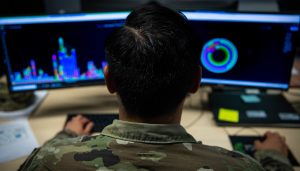Beyond the myths: What labor trafficking really looks like in Nebraska

Labor trafficking is often portrayed as a distant crime or something carried out by strangers in dramatic situations. In Nebraska, the reality is far quieter and much closer to home. Service providers say cases are emerging in everyday workplaces and neighborhoods, usually without the public ever noticing.
At a symposium in Omaha, Heartland Family Service is outlining how labor trafficking happens, why it stays hidden and what Nebraska can do about it.
Andrea Cary, program director at Heartland Family Service, said families often have a narrow or inaccurate idea of what trafficking looks like. The organization trains service providers across the state on how to identify the signs.
“We’re really talking about screening, identification, cultural considerations, what we should be aware of in our community, what oftentimes labor trafficking looks like versus what it doesn’t look like,” Cary said.
What labor trafficking really looks like
Many cases start without force or abduction. Cary said most victims do not encounter traffickers in parking lots or through kidnappings.
“Your child isn’t going to be snatched in a parking lot. It is going to be somebody that they meet online, that they’re groomed, talking to somebody that they have a relationship with,” she said.
For adults, the risk often comes from vulnerability. Cary said victims may be struggling with substance use, mental illness, homelessness, housing instability or domestic violence.
“When it comes to adults, they’re typically very vulnerable individuals,” she said. “Those are all preceding conditions to experiencing trafficking.”
Traffickers often present themselves as helpers. They may offer work, a place to stay or a way to support family. But those promises can shift quickly.
“It oftentimes starts as maybe a wage violation, but can quickly turn into more than just a wage violation where there is control, coercion, manipulation,” Cary said.
Heartland Family Service often identifies cases only through screening. Cary said people rarely use the word “trafficking” to describe what is happening to them.
“This is not just a survivor issue,” she said. “This is an everyone issue […] these issues are going to continue to compromise our system until we start having larger conversations around how do we address the unmet needs in our community?”
National data shows trafficking is widespread
National data shows how widespread the problem is. The National Human Trafficking Hotline identified 11,999 trafficking cases in 2024 involving more than 21,000 victims. Of those, 2,220 were labor trafficking.
According to global estimates from the International Labour Organization, about 77% of trafficking victims worldwide are exploited through forced labor rather than commercial sex. The ILO is a United Nations agency that tracks labor conditions around the world and produces some of the most widely used global trafficking estimates.
U.S. experts say domestic forced labor cases remain underdetected and that reliable national numbers are still limited.
Researchers in Nebraska say the crime is even more hidden than those numbers suggest.
Nebraska study reveals how hidden the problem is
Teresa Kulig, an associate professor in the UNO School of Criminology, studies both sex and labor trafficking and co-directs the university’s Victimology and Victim Studies Research Lab.
“Labor trafficking, identifying and responding to trafficking in general is really challenging, both for law enforcement and service providers,” she said.
Kulig and her team conducted a two-year statewide study that surveyed nearly 600 service providers. Within that study, 170 said they had worked directly with labor trafficking survivors.
“Anyone can be trafficked,” she said. She added that survivors in the study included adults and children from a range of racial and ethnic backgrounds.
“If we’re thinking about labor trafficking, specifically looking at our study here in Nebraska, these were folks. They were both adults and kids who were exploited,” Kulig said. “They were primarily Hispanic or Latino. However, there were other respondents who noted that they had worked with survivors of all racial and ethnic backgrounds.”
The research found cases across a wide range of workplaces.
Kulig said service providers reported cases in “venues like agriculture, domestic servitude, factories, hotels, motels, beauty salons, restaurant food industry, construction.” But the common thread was not the location.
“The common thread […] was that it was less about the specific venue and it was more about very difficult, labor intensive work that people were being exploited in,” she said.
Kulig said trafficking can remain hidden for long periods because labor does not require public transactions. Victims may be isolated in private homes, factories or rural areas where very few people interact with them.
Researchers call for stronger statewide coordination
The study outlined several recommendations. Kulig said Nebraska has strong partnerships in place through the Nebraska Human Trafficking Task Force and Project Harmony. Even so, providers across the state say they need more tools.
“I do think that Nebraska is really well situated to tackle trafficking,” Kulig said. “Some of the things that came up […] is really this need to prioritize raising awareness.”
The recommendations include expanding screening tools for service providers, improving cross-agency collaboration between advocates, law enforcement and attorneys and creating more consistent ways to track labor-trafficking cases.
Researchers also suggested a more centralized statewide approach so individual agencies are not left to handle a complex crime on their own.
The post Beyond the myths: What labor trafficking really looks like in Nebraska appeared first on Straight Arrow News.





